Global Automotive Fascia Market Size and Trends
The automotive facia market is estimated to be valued at US$ 24.77 Bn in 2025 and is expected to reach US$ 35.58 Bn by 2032, growing at a compound annual growth rate (CAGR) of 5.3% from 2025 to 2032.
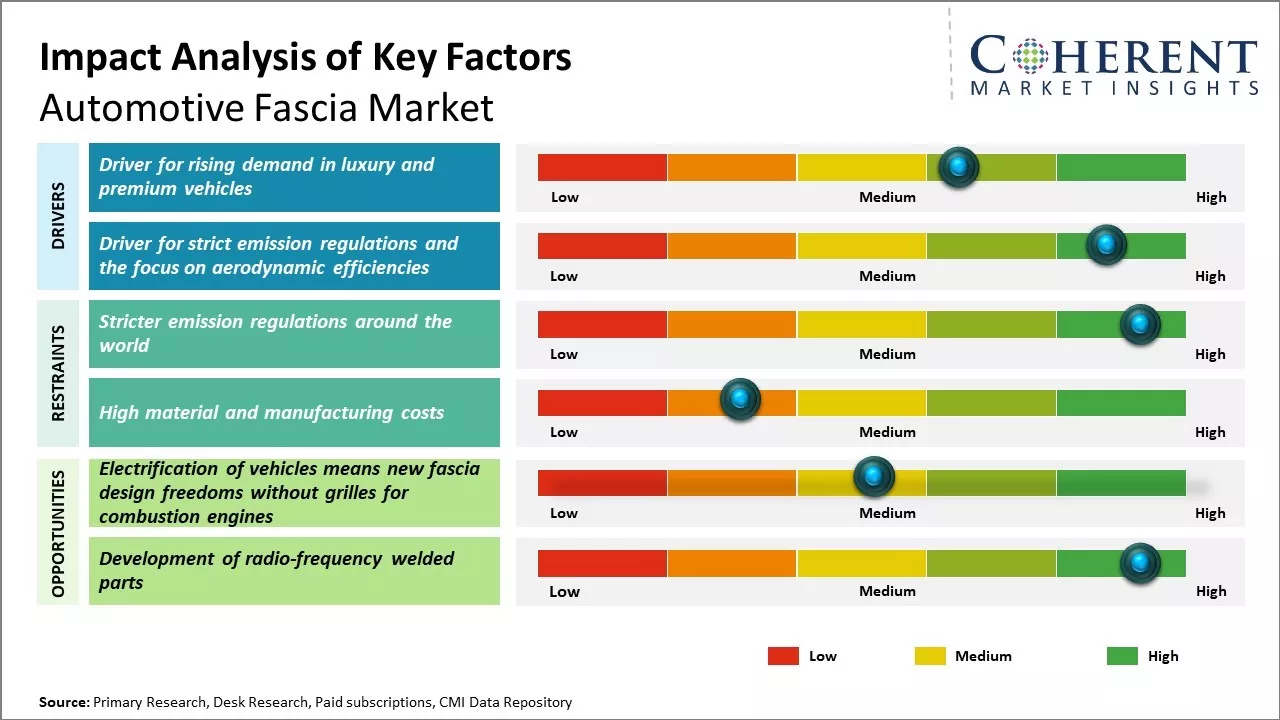
Discover market dynamics shaping the industry: Download Free Sample
Significant reduction in weight and improved aesthetics offered by advanced materials such as carbon fiber, synthetic leather, and composites in fascia are expected to drive their adoption. In addition, rising automobile production coupled with the demand for lightweight and fuel efficient vehicles are expected to boost the demand for automotive fascias. Furthermore, increasing spending capacity of consumers have increased the preference for vehicle personalization, which is expected to augment the demand for upgraded and designer fascias. However, high material and production cost associated with premium and lightweight fascias may hinder the market growth over the forecast period.
Driver for rising demand in luxury and premium vehicles
With the steady rise in disposable incomes across major economies, consumers are increasingly opting for luxury and premium vehicles. There is a strong desire among the affluent class to own a high-end brand as a status symbol. This presents significant opportunities for automakers dealing in luxury brands. Luxury vehicles are known to feature premium interiors with sophisticated trims, fine upholstery, and supple leather. Fascia plays a central role in lending a luxurious appeal to the exteriors. Luxury automakers extensively focus on designing bold, sleek, and stylish fascias integrated with the latest lighting technologies to attract well-heeled customers.
Furthermore, automakers are also keenly aware that small styling changes to the fascia can make a vehicle look substantially refreshed without major investments. This makes fascia an important area for regular modifications that signal to customers that their luxury vehicle remains contemporary. It allows brands to extend the life of their existing models and boost residual values. This has prompted luxury automakers to place greater emphasis on differentiating their fascias from preceding models through signature designs and premium materials. The increasing discretionary spending on luxury possessions drives the continuous demand for distinctive luxury vehicular experiences, ensuring a robust market for automotive fascias catering to this segment.
Market Concentration and Competitive Landscape
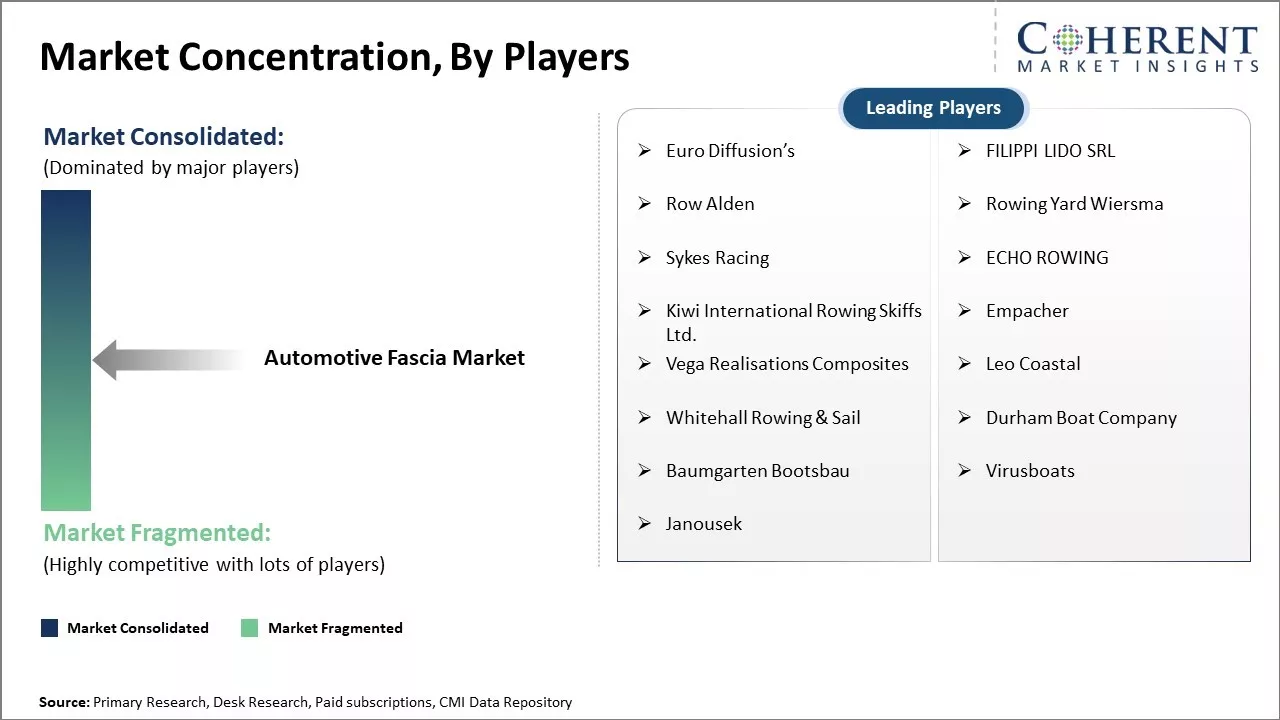
Get actionable strategies to beat competition: Download Free Sample
Driver for strict emission regulations and the focus on aerodynamic efficienciesAutomotive engineering has become increasingly complex with the stringent emission norms and fuel efficiency benchmarks set by regulatory bodies across major markets. Achieving optimal aerodynamic performance has risen to become a key design determinant for new vehicles. The fascia plays a pivotal role in airflow management and sculpting the front profile of a vehicle for reduced drag. Many automakers invest substantially in computational fluid dynamics simulations early on in vehicle development programmes to optimize front-end designs for aerodynamic efficiencies.
Significant resources also go into testing multiple fascia prototypes in wind tunnels before finalizing the production design. Regulators likewise evaluate front-end designs and aerodynamic attributes during compliance testing. Any issues identified typically lead to a re-design of the fascia geometry, surface finishes, or underlying reinforcements. Additionally, the integration of active air flaps and grille shutters controlled by sensors further complicates fascia assembly requirements. To meet tightening mandates, fascia design and engineering require deeper involvement from testing agencies and deeper technical expertise from manufacturers.
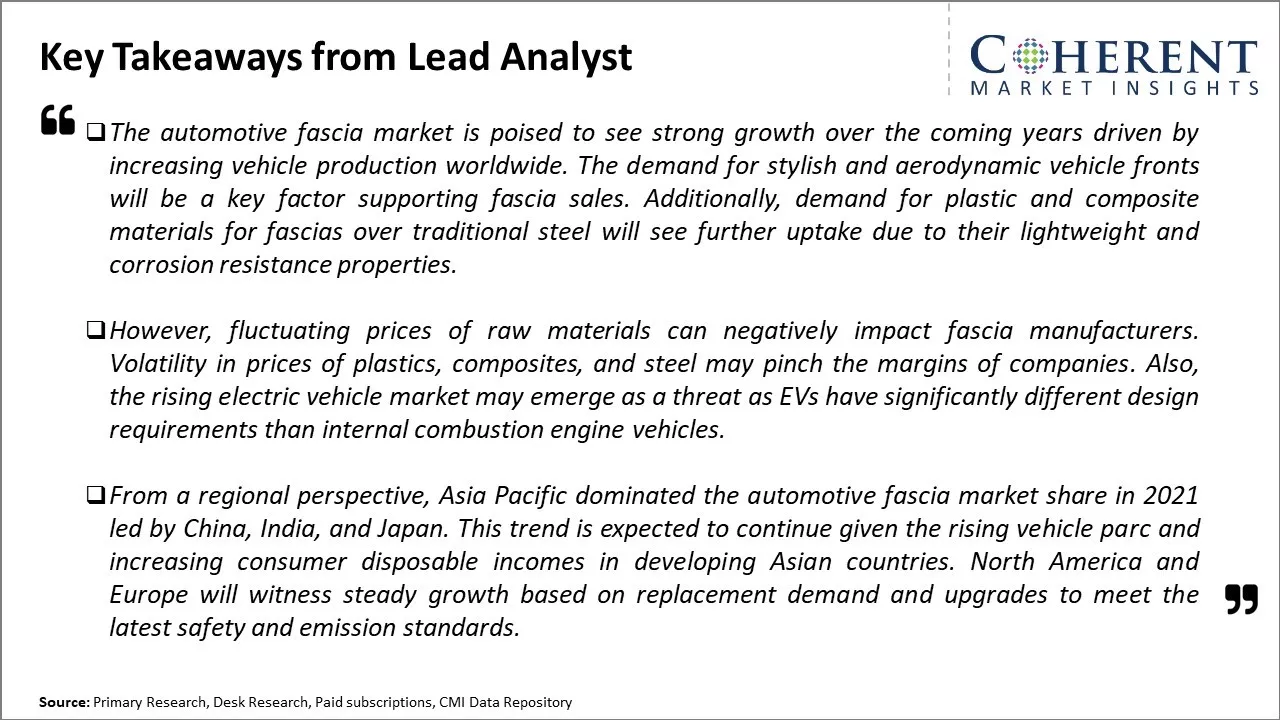
To learn more about this report, Download Free Sample
Market Challenges: Stricter emission regulations around the worldStricter emission regulations around the world require vehicles to become more aerodynamic, placing pressure on fascia design to improve airflow. Fascias must also accommodate newer driver assistance technologies that utilize sensors embedded in the front end. Rising material and production costs amid a global supply chain crunch also pressure margins. Designing fascias that meet all regulatory, technology, and cost requirements is challenging manufacturers.
Market Opportunities: Electrification of vehicles means new fascia design freedoms without grilles for combustion engines
When vehicles go electric, it opens up opportunities for fresh designs without the need for traditional grilles found on combustion engines. Self-driving technologies will demand new sensor configurations and designs. As personal transportation shifts towards connectivity, entertainment, and mobility services, vehicle exteriors including fascias will see demand for customizable and expressive styling options.
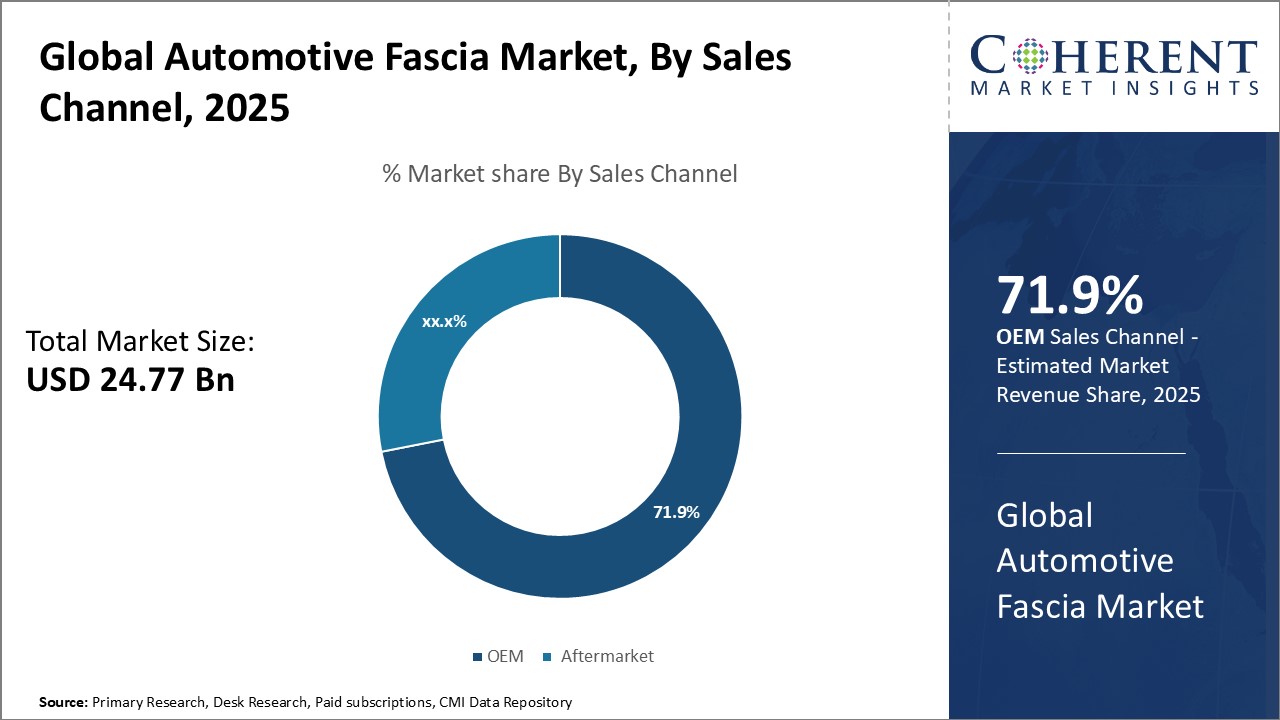
Discover high revenue pocket segments and roadmap to it: Download Free Sample
Insights, By Sales Channel- Manufacturers' Necessity to Source Directly from FabricatorsIn terms of sales channel, OEM contributes the highest share of the automotive fascia market owing to manufacturers' need for direct control and customization during the production process. As the creators of vehicle brands and models, automakers rely on fascia components to help deliver the styling, aerodynamics, and performance expected of their designs. Sourcing directly from fabricators through OEM contracts allows car companies to work closely with suppliers on specs, tolerances, materials selection, and tooling needs. This ensures fascia pieces will integrate seamlessly into vehicle assembly and meet all requirements for structural rigidity, pedestrian safety standards, and the manufacturer's distinctive aesthetic vision. Going through an OEM sales channel also gives automakers bargaining power to negotiate competitive pricing for high-volume production runs. With intense competition and tight margins, car companies try to control costs at all stages, making direct contracts an appealing choice over buying finished parts from aftermarket distributors.
Insights, By Position- Prominence and Protection is Critical for Front Fascia
In terms of position, front fascia is expected to contribute the highest share of 63.7% in 2025 due to its prominence and protective functions. As the most visible part of a vehicle's exterior, the front end greatly influences first impressions and is key to brand identity. Automakers emphasize attention-grabbing grille and lighting designs that stand out among competitors on the road. The front fascia also serves a crucial role shielding undercarriage components from road debris and minor collision impacts. Its durable construction and impact-absorbing materials help prevent damage to more expensive core elements like the radiator, headlights, and sensors located behind it. Well-engineered front fascias aid pedestrian safety as well, with impact-absorbing designs that reduce injury in worst-case scenarios. These factors make the front fascia a high-value component for manufacturers to focus engineering resources on perfecting visually and functionally.
Insights, By Vehicle Type- Mass Market Appeal Drives the Passenger Vehicle Demand
In terms of vehicle type, passenger vehicles is expected to contribute the highest share of the automotive fascia market accounting for 60.3% of the market share in 2025 to their mass appeal among consumers. As the predominant vehicle category worldwide and the focus of automakers, passenger cars, Sports Utility Vehicles (SUVs), and minivans make up a large addressable market for exterior styling parts. For commuters, families, and individuals with non-commercial transport needs, personal vehicles are a necessity as well as a lifestyle investment. Automakers therefore place strong emphasis on maximizing passenger vehicle sales through desirable designs, frequent model refreshes, and option packages. Fascia pieces are an essential element of this, helping deliver exciting new styling cues that keep buyers interested in the latest versions. Aftermarket demand also remains high as personal vehicle owners frequently replace parts for repairs or personalized looks. Commercial vehicles, while critical for businesses, have a more focused set of utilitarian priorities over aesthetics. This concentrated attention on passenger models significantly boosts their fascia market potential compared to other segments.
Regional Insights
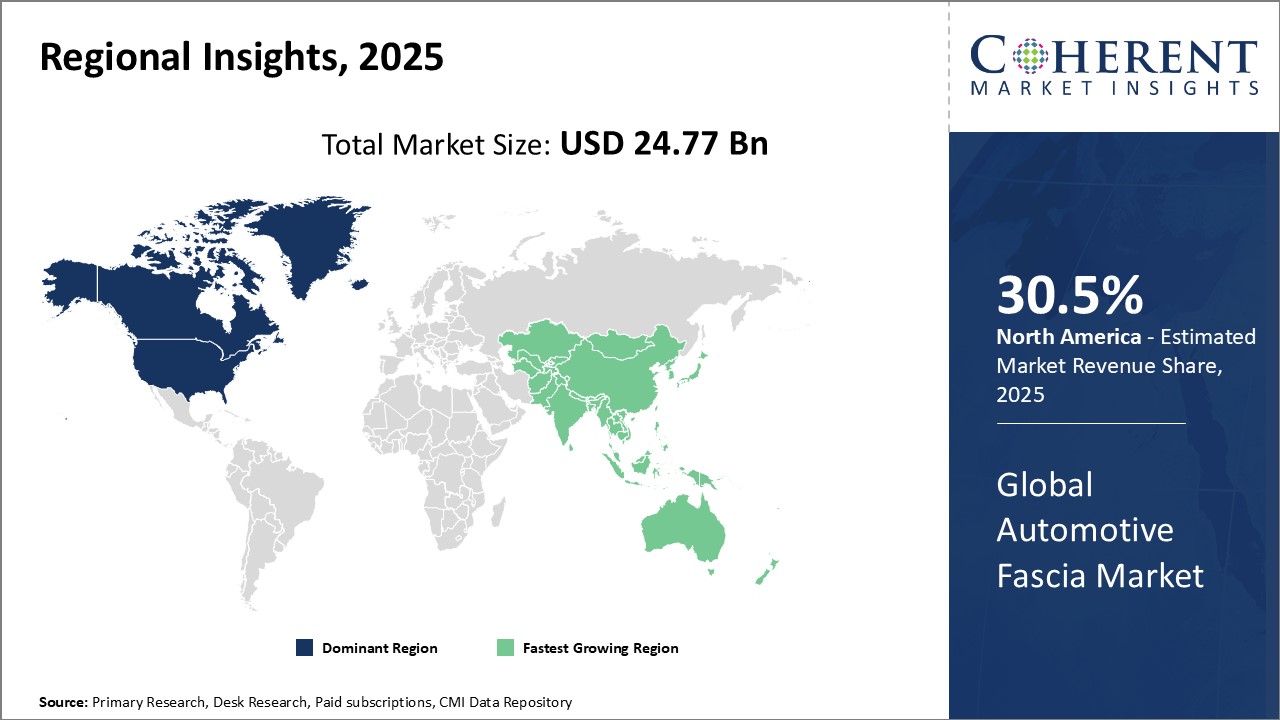
Need a Different Region or Segment? Download Free Sample
North America has been dominating the global automotive fascia market for many years owing to 41.2 of the market share in 2025 to a strong presence of auto manufacturers in the region. The U.S. alone accounts for more than 30.5% of global vehicle production annually. With leading OEMs, such as General Motors, Ford, and FCA, generating huge sales volumes each year, the demand for exterior automotive body parts including fascia remains consistently high. Additionally, North American consumers prefer larger SUVs and trucks which utilize more plastic for front and rear end parts compared to other vehicle segments. This works to the fascia market's advantage in the region.
A major export market for North American fascia manufacturers is Mexico, where several automakers have manufacturing facilities to serve the North American Free Trade Agreement (NAFTA) region. Low-cost manufacturing and easy access to the U.S. and Canada makes Mexico an important production base. Several Tier 1 parts suppliers have also set up facilities near OEM plants in Mexico to capitalize on supply contracts. This facilitates strong domestic as well as cross-border sales volumes. Though China has emerged as a low-cost manufacturing hub globally, North America still leads in fascia production technology and design competence.
Moving ahead, the Asia Pacific region is poised to witness the fastest growth in the automotive fascia market over the coming years. The market in China especially is on an upward swing driven by growing domestic auto sales as well as rising number of international OEMs setting up local factories. Many leading global fascia suppliers have established joint ventures with Chinese partners to address this burgeoning demand. Other countries like India, Indonesia, and Vietnam are also witnessing steady year-on-year vehicle sales increase. As local production volumes rise across major Asia Pacific nations, the need for fascia components from Tier 1 suppliers will spike significantly. The competitive pricing and large profit margins in Asia Pacific attract several players to boost production capacities in the region. Going forward, the APAC market will play a key role in the global fascia market expansion.
Market Report Scope
Global Automotive Fascia Market Report Coverage
| Report Coverage | Details | ||
|---|---|---|---|
| Base Year: | 2024 | Market Size in 2025: | USD 24.77 Bn |
| Historical Data for: | 2020 To 2024 | Forecast Period: | 2025 To 2032 |
| Forecast Period 2025 to 2032 CAGR: | 5.3% | 2032 Value Projection: | USD 35.58 Bn |
| Geographies covered: |
|
||
| Segments covered: |
|
||
| Companies covered: |
Magna International, Inhance Technologies, Flex-N-Gate Corporation, Dongfeng Electronic Technology Co. Ltd., Eakas Corporation, MRC Manufacturing, Chiyoda Manufacturing, Sanko GOSEI, Gestamp Automocion, Plastic Omnium, Aisin Corporation, Dakkota Integrated System LLC, Revere Plastics System, Guardian Industries, Samvardhana Motherson, Toyoda Gosei |
||
| Growth Drivers: |
|
||
| Restraints & Challenges: |
|
||
Uncover macros and micros vetted on 75+ parameters: Get instant access to report
Global Automotive Fascia Industry News
- In April 2023, Skoda is a car manufacturer based in the Czech Republic revealed plans to enhance its car grille technology to include safety signals for pedestrians, like green arrows and figures, as part of automotive fascia
- In February 2023, BMW is a German multinational corporation that primarily produces luxury vehicles and motorcycles. applied for a patent with the World Intellectual Property Organization (WIPO) for its signature kidney grille, aiming to integrate a single light-emitting panel that can be controlled to conceal certain elements
- In January 2023, a Canada-based automotive fascia manufacturer, Plasman, announced the successful delivery of its spoiler and front grille product to Honda is a Japanese multinational corporation primarily known for manufacturing automobiles, motorcycles, and power equipment. for the new CR-V model
- In November 2022, MG India is the Indian subsidiary of SAIC Motor Corporation Limited, a Chinese automotive giant. began testing its upcoming SUV model, the MG Hector facelift, featuring an improved design of its diamond grille covering and dual barrel headlights, along with fog lights and Daytime Running Lights (DRLs) in the front fascia
*Definition: The automotive fascia market includes products related to the front fascia/bumper of a vehicle. The front fascia is a decorative and protective panel that is integrated into the vehicle's bodywork at the front. The automotive fascia market encompasses products like OEM front fascias, carbon fiber front fascias, integrated front light fascias, repair and replacement front fascias, front fascia kits, and other related aftermarket parts and accessories.
Market Segmentation
- Sales Channel Insights (Revenue, US$ BN, 2020 - 2032)
- OEM
- Aftermarket
- Position Insights (Revenue, US$ BN, 2020 - 2032)
- Front Facia
- Rear Facia
- Vehicle Type Insights (Revenue, US$ BN, 2020 - 2032)
- Passenger Vehicle
- Commercial Vehicle
- Regional Insights (Revenue, US$ BN, 2020 - 2032)
- North America
- U.S.
- Canada
- Latin America
- Brazil
- Argentina
- Mexico
- Rest of Latin America
- Europe
- Germany
- U.K.
- France
- Italy
- Russia
- Rest of Europe
- Asia Pacific
- China
- India
- Japan
- Australia
- South Korea
- ASEAN
- Rest of Asia Pacific
- Middle East & Africa
- GCC Countries
- South Africa
- Rest of Middle East & Africa
- North America
- Key Players
- Magna International
- Inhance Technologies
- Flex-N-Gate Corporation
- Dongfeng Electronic Technology Co. Ltd.
- Eakas Corporation
- MRC Manufacturing
- Chiyoda Manufacturing
- Sanko GOSEI
- Gestamp Automocion
- Plastic Omnium
- Aisin Corporation
- Dakkota Integrated System LLC
- Revere Plastics System
- Guardian Industries
- Samvardhana Motherson
- Toyoda Gosei
Share
Share
About Author
Gautam Mahajan is a Research Consultant with 5+ years of experience in market research and consulting. He excels in analyzing market engineering, market trends, competitive landscapes, and technological developments. He specializes in both primary and secondary research, as well as strategic consulting across diverse sectors.
Missing comfort of reading report in your local language? Find your preferred language :
Transform your Strategy with Exclusive Trending Reports :
Frequently Asked Questions
EXISTING CLIENTELE
Joining thousands of companies around the world committed to making the Excellent Business Solutions.
View All Our Clients
